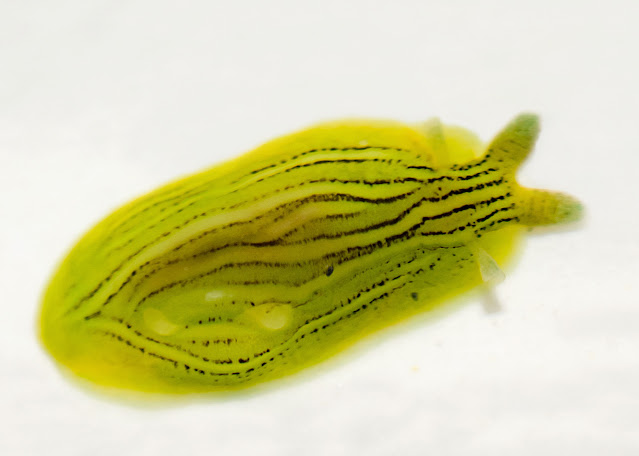A bit of excitement today. The sun came out, and I went to Oyster Bay to look for shells for my hermits. I found four, the wrong species, but maybe they'll be acceptable. Hermit crabs can be picky.
The tide was high again, and the waves were rambunctious, busy tossing eelgrass onto the shore, all fresh, with roots and all. I collected a fair amount; the hermits love it, and it can be stored for a while in a bucket of sea water.
At home, I washed it all, getting rid of fragments that would clog the filters, and put a few of the larger clumps in the tank. Later, after I'd done a bit of maintenance, I noticed a yellow blob of jelly on one of the blades of eelgrass. Looked like eggs, but not quite. Wrong shape, slightly stripy. I fished it out and looked at it under a loupe: it was too small to see clearly with the magnifying lens. Not eggs. A baby sea hare!
The "Zebras" live on eelgrass, eating the small organisms that grow on the blades. I found one once before, in
November of 2013; it was bigger, three times the size of this one. Zebras lay their eggs in the summer, and they hatch into crawling miniatures of the adults, with no swimming stage in between. They grow, usually, to about 4 cm.
They are related to the nudibranchs, or sea slugs, but the nudibranchs carry their gills outside their body (hence "nude gills" = nudibranch) and the sea hares' gills are inside, under a fold at the back. On the head there are two tentacles and the rhinopores, which sense tastes and scents.
They live exclusively on eelgrass, and are well camouflaged, blending in to the color, always orienting themselves lengthwise on the blades, and with stripes that echo the stripes of mature eelgrass.
Being tossed and rolled and scraped across the sand is stressful. I hoped that "Zeeby" would be ok, and I checked on him several times; he moved to the tip of his eelgrass blade, and sat there until a hermit found him. When I looked, the hermit was eating him. So sad!
Hermits are scavengers. They do not eat live critters. They ignore healthy eggs and crawling snails and open barnacles. When the animals are dead or dying, though, they pounce. It's their job. So I guess that "Zeeby" must have been too badly damaged by his trip through the surf to make it.
~~~~~~~~~~~~~~~~
Hoy hice un hallazgo. Salió el sol, y fui a Oyster Bay a buscar conchas para mis ermitaños. Encontré cuatro; no son de la especie que prefieren los ermitaños, pero tal vez se conformen. Los ermitaños pueden ser exigentes.
La marea estaba alta otra vez, y las olas hacían alboroto, muy ocupadas en aventar plantas enteras de Zostera marina, con todo y raices, a la playa. Recogí una buena bolsa llena; a los ermitaños les gusta, y puedo guardar lo sobrante en una cubeta de agua de mar.
Lavé la Zostera, y coloqué varias plantas en el acuario. Después de hacer algunos quehaceres de mantenimiento, estaba mirando el acuario, cuando vi una bolita como de jalea amarilla.Parecían huevos de caracol, pero no exactamente; tenía manchas como de rayas oscuras. La saqué y la miré con una lupa fuerte: era demasiado chica para mi lente de 10x. No eran huevos. ¡Una liebre marina infantil!
Es una liebre "Zebra", o liebre de Taylor, Phyllaplysia taylori. Estos animalitos viven en la planta Zostera, comiendo los organismos que allí crecen. Hace algunos años, encontré otro, más grande; este era de 3mm. de largo, y aquel de 1cm. Los Zebra ponen sus huevos en el verano, y eclosionan como adultos miniaturos, sin pasar por una etapa de natación. Llegan a crecer hasta más o menos 4cm.
Son parientes de las babosas marinas, los nudibranquios, pero las agallas de los nudibranquios las llevan afuera del cuerpo; las liebres marinas las llevan por dentro, bajo una doblez en el dorso. En la cabeza llevan dos tentáculos y dos rinóforos, órganos sensorios que identifican sabores y olores.
Viven exclusivamente en la hierba Zostera, y tienen camuflaje excelente, tanto que se desaparecen, llevando el mismo color y diseño que la hierba, con sus rayas que copian las de la hierba.
Arrancarse de su sitio, voltearse, aventarse y arrastrarse sobre la arena es traumático. Esperaba que "Zebrita" saldría adelante, pero de vez en cuando, iba a buscarla para ver como estaba. Se fue hasta la punta de su hoja de Zostera, y allí la encontró un ermitaño. Cuando miré, el ermitaño la estaba comiendo. ¡Tan triste!
Los ermitaños no comen carne viva. Son carroñeros; comen detritos. Cuando encuentran huevos vivos, las pasan de alto; lo mismo con caracoles o bálanos vivos, o cualquier otro animal vivo. Si los encuentran muertos o casi muertos, los comen. Es su trabajo.
Parece que la pobre Zebrita estaba demasiado dañada para sobrevivir. No la rescaté a tiempo.




